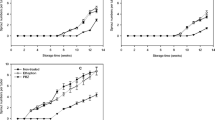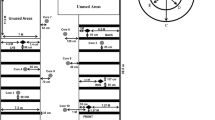Summary
Headspace and residue concentrations of chlorpropham were determined in a box potato store at the start of the storage season. The concentration of headspace chlorpropham was in the range 0.3–1.3 μg per 10 dm3. The headspace chlorpropham concentration was found to be higher before the initial application of chlorpropham to the stored tubers than after the application, probably partly due to differences in storage temperature. Concrete samples taken from the floor and walls and wood samples from the potato boxes showed that considerable residues of chlorpropham had built up in the fabric of the store.
Zusammenfassung
Rückstands-und Luftraum-Analysen dienten zur Messung der Chlorpropham-Konzentration am Anfang der Lagersaison in einem seit vier Jahren für Kartoffellagerung verwendeten Kartoffelboxenlager. Die Probenahme im Lager erfolgte, bevor die erste Anwendung von Chlorpropham für die Kartoffeln der neuen Vegetationsperiode (Luftraum-und Rückstandsproben) und erneut 5 Wochen nach der Kartoffelbehandlung mit Chlorpropham (nur Proben aus dem Luftraum). Die Tabellen 1 und 2 zeigen die Ergebnisse der ersten bzw. zweiten Rückstandsanalyse. Die Ergebnisse der Rückstandsanalysen von Gang, Wänden und Boxen zeigt Tabelle 3, und die Entnahmestellen der Proben ergeben sich aus Abbildung 1. Die Konzentrationen des Chlorpropham im Luftraum lagen im Bereich von 0,3–1,3 μg pro 10 dm3. Vor der ersten Kartoffelbehandlung mit Chlorpropham ergaben sich beim ersten Untersuchungstermin höhere Gesamtkonzentrationen als nach dem zweiten Termin, nachdem die Knollen behandelt worden waren. Dieser Effekt lässt sich teilweise auf die höhere Temperatur der Lagerluft von 12°C beim ersten Untersuchungstermin zurückführen, im Vergleich zu 9°C beim zweiten Termin. Die Rückstandsanalysen zeigten, dass Gang, Wände und Boxen im Lager hohe Konzentrationen von Chlorpropham akkumuliert und absorbiert hatten (Tabelle 3). Das Rückstands-Chlorpropham wird als Ursache für das Luftraum-Chlorpropham angesehen, vor allem jenes, welches zum ersten Untersuchungstermin, vor der Knollenbehandlung, gefunden wurde.
Résumé
Des analyses de répartition et de résidus sont réalisées afin de connaître les concentrations de chlorpropham avant le stockage des pommes de terre en caisses-palettes, dans un bâtiment ayant déjà servi à cet effet depuis quatre ans. Les échantillons sont prélevés avant l'application du chlorpropham (pour la répartition et les résidus) et cinq semaines après le traitement (pour la répartition seulement). Les résultats de la première et deuxième analyse pour la répatition, sont regroupés respectivement dans les tableaux 1 et 2. Ceux de l'analyse des résidus dans le sol, les parois et les caisses-palettes, sont donnés dans le tableau 3, les zones de prélèvement dans la figure 1.
Les concentrations de chlorpropham dans l'air ambiant varient entre 0.3 et 1.3 μg par 10 dm3. Elles sont toutes plus élevées à la première date, avant l'application du chlorpropham, qu'à la deuxième date, après traitement.
Cet effet est en partie expliqué par une température plus élevée à la première date, 12°C, contre 9°C à la deuxième date.
L'analyse des résidus montre que le sol, les parois et les caisses ont accumulé des concentrations élevées de chlorpropham (tableau 3), par absorption des résidus dans ces matériaux.
Le chlorpropham résiduel peut être à l'origine du produit analysé dans l'air, en particulier celui présent à la première date, avant traitement des tubercules.
Similar content being viewed by others
References
Boyd, W. D. & H. J. Duncan 1986. Studies on potato sprout suppressants. 6. Headspace analysis of tecnazene and chlorpropham in a large scale box potato store.Potato Research 29: 000–000.
Filmer, A. A. E. & D. G. Land, 1978. The accumulation of volatile substance in a large scale modern potato store.Journal of the Science of Food and Agriculture 29: 219–224.
Author information
Authors and Affiliations
Rights and permissions
About this article
Cite this article
Boyd, W.D., Duncan, H.J. Studies on potato sprout suppressants. 7. Headspace and residue analysis of chlorpropham in a commercial box potato store. Potato Res 29, 217–223 (1986). https://doi.org/10.1007/BF02357652
Accepted:
Issue Date:
DOI: https://doi.org/10.1007/BF02357652




